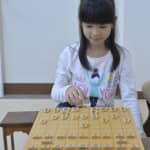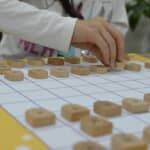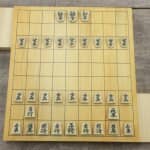Shogi 6 February 2020
Things That Shogi Beginner Children Often Get Confused with: #8 Number Based Attack
*Please note that the Kanji numbers in pictures are spelled in English in the text. The following Shogi boards have a face with files (vertical rows) numbered 1 through 9, from right to left, and ranks (horizontal rows) designated with Kanji characters, “一” (One) to “九” (Nine), from top to bottom. On the other hand, in the text, each Kanji character is replaced with an alphabet, from “a” to “i” : “一” with “a”, “二” with “b”, … and “九” with ”i”.
Let’s Review on What a “Number Based Attack” Is.
Number based attack is one of necessary techniques required to become stronger, which is also one of the main theme of “Shogi Lesson Book for Beginners Vol. 3“. Specifically, this technique is used to break your opponent’s camp. Using this technique, you count the numbers of all pieces which are effecting on the targeted square. Comparing the counted number of your pieces and that of your opponents’, you decide whether you need to add or reduce pieces, which can influence on the targeted square.
To use this technique, as the first step, decide which square you will attack. On the second step, you count the number of all pieces whose reaching power is covering the targeted square. As the final step, provided that the counted number of your pieces is bigger than that of your opponent’s, try to break your opponent’s camp.
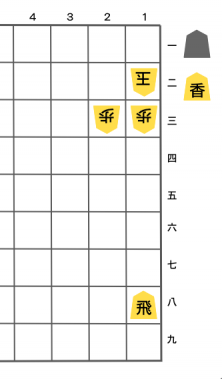
In the above situation, the numbers of your pieces and that of your opponent’s pieces, pieces whose reaching power is influencing the square of 1 三 (1 c), are the same. If no measures are taken, you can’t break the opponent’s camp.
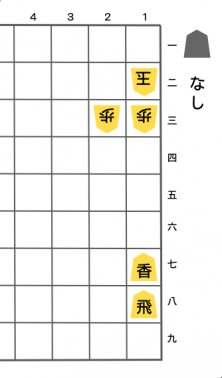
You may want to drop a hand piece of Kyosha (Lance) to add reaching power effecting on the targeted square.
Things that Children Often Get Confused with Number Based Attack
The basis of this technique is simple, but you may find it difficult to apply in the real game situation.
I brought together several types of number based attack by adding, which Shogi beginner children are likely to get confused with.
1. Tend to Be Hesitate in Attacking the Square with Pieces Around
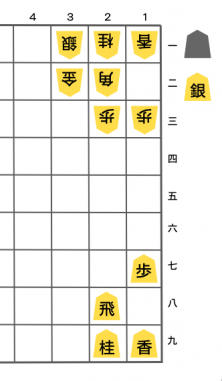
Look at the situation of a picture #3. As the step one, decide which square you will attack. In the situation, the targeted square is one of 2 三 (2 c). Finding this square is the point here for children to get confused with.
Why children can’t it difficult to find the targeted square in this area is because there are many pieces and apparently it seems hard to attack this area.
Is that true? As the second step, counting the number of pieces whose reaching power is covering the targeted square, 2 三 (2 c), you will get to know both you and your opponent have one piece, Hisha (Rook) and Kin (Gold). If the situation is left unchanged and you start to attack moving Hisha (Rook) to the square of 2 三 (2 c), your attack will fail and Hisha (Rook) will be taken by Kin (Gold). What about using your hand piece of Gin (Silver) on the square of 3 四 (3 d), ▲S-3d*?
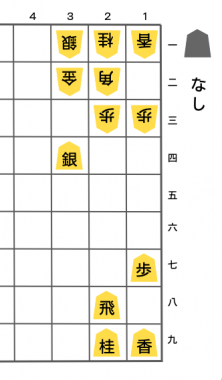
Gin (Silver) , and you will have one more piece than your opponent.
The number of your pieces whose reaching power is covering the square of 2 三 (2 c) is two, Hisha (Rook) and dropped Gin (Silver). That of the opponent’s pieces is one of Kin (Gold). Even if the opponent moves Fu (Pawn) or another piece, you can break the opponent’s camp: ▲S-2c+, △G-2c, and ▲R-2c+. As the picture of #5 is showing , you can break the castle.
Like the above situation, most times which seem to be hard for you to attack, knowing the number of reaching power exactly and dealing with the situation appropriately, you can break the camp without many difficulties.
For beginners, in particular, attacking the area in which there are major pieces require them to have courage. Here, it’s a good idea to understand that Kaku (Bishop) stays in close to the targeted square and won’t be able to move to the targeted square, 2 三 (2 c).
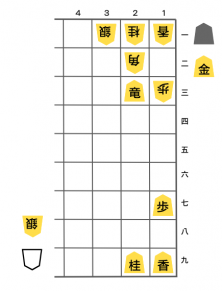
2. Can’t Use Pieces on a Board

You are a Sente player. Let’s think how to move a piece on your next move. First, what you need to do is to decide a targeted square and count the number of all pieces whose reaching power is covering the targeted square.
The targeted square should be the one of 1 三 (1 c). Count the numbers of all pieces whose reaching power is covering the square. You have one piece, Kei (Knight), and your opponent has also one piece, Gin (Silver). The numbers are the same, therefore you shouldn’t attack.
What if I advise you to think about using a number based attack? Children often get confused with the advice and say, “I can’t do it, because I have no piece”.
You can apply a number based attack in this situation, moving Hisha (Rook) on a board to the square of 1 六 (1 f). Shogi beginner children are more likely to find it difficult to use a number based attack when they don’t have hand pieces.
Why is it difficult for children? It is because looking over the entire situation on a board is difficult for beginner children.
To deal with this difficulty, I tell children, “keep in mind that you need to have a good view on the whole board.” Children often look at only the pieces that are moving. I try to improve their power of observation.
3. Can’t Drop a Piece within an Opponent’s Camp
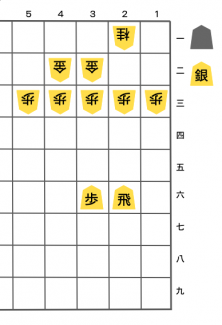
Let’s look at the last issue. In the situation shown in the picture #7, you may get a sense of deciding a targeted square. You are aiming at moving and promoting Hisha (Rook) and may want to target the square of 2 三 (2 c). You will check the numbers of reaching power and get to know that you have one, Hisha (Rook), and your opponent also has one, Kin (Gold).
You would notice that you can’t attack if you go on like this, but you can apply a number based attack if you use a hand piece of Gin (Silver).
You may drop the hand piece in your mind, dropping on the square of 3 四 (3 d), 2 四 (2 d), and 1 四 (1 d)…and say, “No, there is no square which I can drop a piece on.”
The above typically happens for children. The reason children can’t find a square where they will drop a piece is that most children try to find the square outside their opponent’s camp.
The appropriate way to drop a hand piece in the situation is dropping it on the square of 1 二 (1 b), which is inside the opponent’s camp.
Apparently, the dropped Gin (Silver) seems to be captured soon by Kin (Gold) coming to the square of 2 二 (2 b). However, your number based attack will be successful: ▲S-2c+, △G-2c, and ▲R-2c+.
The above is the example of a number based attack, in which you take advantage of a feature of Gin’s moves, a feature which allows Gin to move diagonally backward. You can drop your hand piece outside your opponent’s camp. Think flexibly to find a better solution.
In this lesson, you learned about a number based attack, by adding particularly. It might be hard for Shogi beginners to attack the area crowded with many pieces, to look over the whole board, or to break into an opponent’s camp. Even so for the beginning, keeping in mind three steps, which you learned in this lesson, will help you count the number of pieces affecting the targeted square and have a good view on the situation on a board.
A Series of Things That Shogi Beginner Children Often Get Confused with
Through teaching Shogi, teachers of i-tsu-tsu Shogi classes have understood things Shogi beginner children often get confused with and have figured out solutions to them. In the series, I provide the way to deal with children’s difficulties in playing Shogi, bringing together the information related to the things they get confused with.
Things That Shogi Beginner Children Often Get Confused with: 5. Difficulty in Use of Hand Piece
https://en.i-tsu-tsu.co.jp/?p=5186
